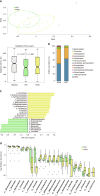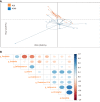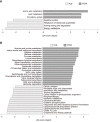Changes in gut microbiota composition and diversity associated with post-cholecystectomy diarrhea
- PMID: 33584071
- PMCID: PMC7856843
- DOI: 10.3748/wjg.v27.i5.391
Changes in gut microbiota composition and diversity associated with post-cholecystectomy diarrhea
Abstract
Background: Post-cholecystectomy diarrhea (PCD) frequently occurs in patients following gallbladder removal. PCD is part of the post-cholecystectomy (PC) syndrome, and is difficult to treat. After cholecystectomy, bile enters the duodenum directly, independent of the timing of meals. The interaction between the bile acids and the intestinal microbes is changed. Therefore, the occurrence of PCD may be related to the change in microbiota. However, little is known about the relationship between the gut microbiota and PCD.
Aim: To better understand the role of the gut microbiota in PCD patients.
Methods: Fecal DNA was isolated. The diversity and profiles of the gut microbiota were analyzed by performing high-throughput 16S rRNA gene sequencing. The gut microbiota were characterized in a healthy control (HC) group and a PC group. Subsequently, the PC group was further divided into a PCD group and a post-cholecystectomy non-diarrhea group (PCND) according to the patients' clinical symptoms. The composition, diversity and richness of microbial communities were determined and compared.
Results: In the PC and HC groups, 720 operational taxonomic units (OTUs) were identified. The PC group had fewer OTUs than the HC group. β-diversity was decreased in the PC group. This indicated decreased microbial diversity in the PC group. Fifteen taxa with differential abundance between the HC and PC groups were identified. In the PCD group compared to the PCND group, significant decreases in microbial diversity, Firmicutes/Bacteroidetes ratio, and richness of probiotic microbiota (Bifidobacterium and Lactococcus), and an increase in detrimental microbiota (Prevotella and Sutterella) were observed. Moreover, a negative correlation was found between Prevotella and Bifidobacterium. Using a Kyoto Encyclopedia of Genes and Genomes functional analysis, it was found that the abundances of gut microbiota involved in lipid metabolism pathways were markedly lower in the PCD group compared to the PCND group.
Conclusion: This study demonstrated that gut dysbiosis may play a critical role in PCD, which provides new insights into therapeutic options for PCD patients.
Keywords: 16S rRNA; Bifidobacterium; Cholecystectomy; Diarrhea; Microbiota; Post-cholecystectomy.
©The Author(s) 2021. Published by Baishideng Publishing Group Inc. All rights reserved.
Conflict of interest statement
Conflict-of-interest statement: The authors declare no conflict of interest.
Figures




Similar articles
-
Disordered Gut Microbiota Correlates With Altered Fecal Bile Acid Metabolism and Post-cholecystectomy Diarrhea.Front Microbiol. 2022 Feb 18;13:800604. doi: 10.3389/fmicb.2022.800604. eCollection 2022. Front Microbiol. 2022. PMID: 35250923 Free PMC article.
-
Gut microbiota alteration after cholecystectomy contributes to post-cholecystectomy diarrhea via bile acids stimulating colonic serotonin.Gut Microbes. 2023 Jan-Dec;15(1):2168101. doi: 10.1080/19490976.2023.2168101. Gut Microbes. 2023. PMID: 36732497 Free PMC article.
-
Intestinal microbiota dysbiosis play a role in pathogenesis of patients with primary immune thrombocytopenia.Thromb Res. 2020 Jun;190:11-19. doi: 10.1016/j.thromres.2020.03.012. Epub 2020 Mar 19. Thromb Res. 2020. PMID: 32272276
-
Progress in the Study of Colorectal Cancer Caused by Altered Gut Microbiota After Cholecystectomy.Front Endocrinol (Lausanne). 2022 Feb 24;13:815999. doi: 10.3389/fendo.2022.815999. eCollection 2022. Front Endocrinol (Lausanne). 2022. PMID: 35282463 Free PMC article. Review.
-
The Specific Alteration of Gut Microbiota in Diabetic Kidney Diseases-A Systematic Review and Meta-Analysis.Front Immunol. 2022 Jun 17;13:908219. doi: 10.3389/fimmu.2022.908219. eCollection 2022. Front Immunol. 2022. PMID: 35784273 Free PMC article.
Cited by
-
Combinatorial Effects of Terpene, Chenodeoxycholic Acid, and Ursodeoxycholic Acid on Common Bile Duct Stone Recurrence and Gallbladder Stone Dissolution.J Clin Med. 2024 Dec 5;13(23):7414. doi: 10.3390/jcm13237414. J Clin Med. 2024. PMID: 39685879 Free PMC article.
-
A commentary on 'Alteration of the fecal microbiome in patients with cholecystectomy: potential relationship with postcholecystectomy diarrhea - before and after study'.Int J Surg. 2024 Feb 1;110(2):1281-1282. doi: 10.1097/JS9.0000000000000870. Int J Surg. 2024. PMID: 37924491 Free PMC article. No abstract available.
-
Mortality and cardiovascular disease after cholecystectomy in type 2 diabetes: A nationwide longitudinal cohort study.J Hepatobiliary Pancreat Sci. 2025 Jul;32(7):514-523. doi: 10.1002/jhbp.12109. Epub 2025 Mar 3. J Hepatobiliary Pancreat Sci. 2025. PMID: 40033631 Free PMC article.
-
The Effect of Increased Intra-Abdominal Pressure on Hemodynamics in Laparoscopic Cholecystectomy-The Experience of a Single Centre.J Pers Med. 2024 Aug 17;14(8):871. doi: 10.3390/jpm14080871. J Pers Med. 2024. PMID: 39202062 Free PMC article.
-
Mapping the global research landscape on nutrition and the gut microbiota: Visualization and bibliometric analysis.World J Gastroenterol. 2022 Jul 7;28(25):2981-2993. doi: 10.3748/wjg.v28.i25.2981. World J Gastroenterol. 2022. PMID: 35978868 Free PMC article. Review.
References
-
- Keren N, Konikoff FM, Paitan Y, Gabay G, Reshef L, Naftali T, Gophna U. Interactions between the intestinal microbiota and bile acids in gallstones patients. Environ Microbiol Rep. 2015;7:874–880. - PubMed
-
- Lamberts MP, Lugtenberg M, Rovers MM, Roukema AJ, Drenth JP, Westert GP, van Laarhoven CJ. Persistent and de novo symptoms after cholecystectomy: a systematic review of cholecystectomy effectiveness. Surg Endosc. 2013;27:709–718. - PubMed
-
- Sciarretta G, Furno A, Mazzoni M, Malaguti P. Post-cholecystectomy diarrhea: evidence of bile acid malabsorption assessed by SeHCAT test. Am J Gastroenterol. 1992;87:1852–1854. - PubMed
-
- Caenepeel P, Janssens J, Vantrappen G, Eyssen H, Coremans G. Interdigestive myoelectric complex in germ-free rats. Dig Dis Sci. 1989;34:1180–1184. - PubMed
MeSH terms
Substances
LinkOut - more resources
Full Text Sources
Other Literature Sources

